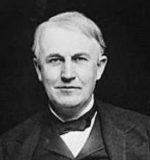Thomas Alva Edison was an American inventor and businessman who lived from February 11, 1847, to October 18, 1931. He created numerous innovations in the production of electric power, mass communication, sound recording, and motion pictures. The phonograph, motion picture camera, and early electric light bulbs are a few of the innovations that have had a significant influence on the contemporary industrialized world. Working with numerous researchers and staff, he was one of the first inventors to incorporate the concepts of organized science and cooperation into the creation process. He founded the first laboratory for industrial research.
The American Midwest served as Edison's upbringing. Some of his earlier innovations were motivated by his early work as a telegraph operator. Many of his early discoveries were created in his first laboratory, which he set up in Menlo Park, New Jersey, in 1876. In the future, he founded two botanical research facilities: one in West Orange, New Jersey, which housed the Black Maria, the world's first film studio, and another in Fort Myers, Florida, where he worked with businessmen Henry Ford and Harvey S. Firestone. Edison is regarded as the most prolific inventor in American history, holding 1,093 US patents in addition to patents in other nations. Edison had six children from two marriages. Due to effects from diabetes, he passed away in 1931.
Early life
His mother, who had worked as a teacher, taught Edison how to read, write, and do math. He just spent a brief period of time in school. One biography, however, characterized him as a very inquisitive youngster who learned most things by reading on his own. He developed a fascination for technology as a child and spent many hours conducting experiments at home.
When Edison was 12 years old, he started having hearing issues. It has been determined that a childhood case of scarlet fever and ongoing, untreated middle ear infections are what caused his deafness. He then created intricate, made-up tales regarding the origin of his deafness. It is said that Edison would listen to a music player or piano by clamping his teeth into the wood to absorb the sound waves into his skull because he was entirely deaf in one ear and hardly hearing in the other. As he became older, Edison thought his hearing loss helped him focus more readily and avoid distractions. Modern historians and medical experts have hypothesized that he might have had ADHD.
Phonograph
With the automatic repeater and other enhanced telegraphic devices, Edison began his career as an inventor in Newark, New Jersey, but it was the phonograph, which he created in 1877, that first brought him widespread attention. The general public found this feat to be so surprising that it seemed nearly miraculous. "The Wizard of Menlo Park" was the moniker Edison acquired.
Carbon Telephone Transmitter
By creating a carbon microphone, which consisted of two metal plates separated by carbon granules that would vary resistance with the pressure of sound waves, Edison started working to enhance the telephone microphone (at the time, referred to as a "transmitter") in 1876. The granules act as a conduit for a constant direct current, which is modulated by the resistance variations. This variable electric current mimics the changing pressure of the sound wave.
Electric Light
In order to compete with gas and oil-based lighting, Edison started developing an electrical lighting system in 1878.He started by trying to figure out how to make an indoor incandescent lamp that would last for a long time. However, the light bulb was not created by Thomas Edison. A coiled platinum filament was used in an effective light bulb created in 1840 by British scientist Warren de la Rue, but the bulb's exorbitant cost of platinum prevented it from becoming a commercial success. Alessandro Volta's 1800 display of a blazing wire and the creations of Henry Woodward and Mathew Evans were only a few of the many other inventors that came up with incandescent lamps. Other inventors of early and economically unviable incandescent electric lamps included Moses G., James Bowman Lindsay, and Humphry Davy.

